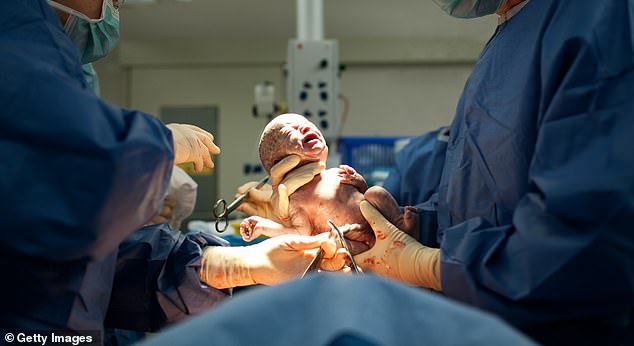Rachel Somerstein had been in labor for nearly 24 hours when someone held a piece of paper up for her to sign.
It was after midnight, in a small hospital in upstate New York, and as her first birth was headed towards an unplanned Cesarean section, she was in no state to read fine print.
Her labor had already gotten off to a complicated start – the anesthesiologist had had to redo her epidural three times.
Now, as her daughter’s heart rate was dropping, she believed her worst fears were about to be realized.
In her book, Invisible Labor: The Untold Story of the Cesarean Section, she recalls: ‘I was certain that this left turn into unknown territory meant that… I would die, that my baby would die.’


The C-section is the world’s most common surgery. In the US it makes up one-in-three births
Her husband later told her the general feeling in the operating room was that she was hysterical. The C-section is, after all, the world’s most common surgery. In the US they make up one-in-three births.
What did she have to worry about?
Rachel remembers being rolled on a gurney to the operating room, where she braced herself against the doula as an anesthesiologist attempted to administer anesthesia. Just as with the epidural, they struggled to place the needle correctly, and while others in the room attempted to hold her back, the physician made the first cut.
“I felt that,” Rachel recalls telling the doctor.
“You’ll feel pressure,” he said.
But Rachel felt everything, every cut.


The separation of her abdominal muscles. The scissors used to move her bladder. The scalpel with which the doctor ‘incised’ her uterus.
The obstetrician later noted that she had been screaming from the pain.
‘My legs, as I remember, and as the doctor wrote, “were moving quite a bit.”
‘They were kicking high enough for me to see them above the drape, rigged so I wouldn’t be able to see what was going on.
Later, she discovered scratches on her hips, which she presumed were from the nurses’ nails as they tried to hold her down.
Afterward, as she recovered, her daughter was brought to her to feed, but Rachel was still in shock – and excruciating pain – and couldn’t bear to see her.
In the immediate aftermath, Rachel felt guilty for rejecting her child in that first moment of need, but later realized it was one of her purest acts as a mother: ‘I didn’t want to associate her with any more of my pain. She was already so bound up with it.’
Two months later, at her final postpartum checkup, she was told she was looking great, but she didn’t feel great. She couldn’t feel her core muscles. Her vulva was numb but sex hurt.
‘A midwife suggested lube, which didn’t work: “It still hurts,” I told her. “More lube,” she said.’
Her own research revealed pelvic floor physical therapy might have helped, but it was never suggested to her. The belief at the time was a C-section ‘spares’ the perineum so pelvic floor PT is unnecessary.
Yet it wasn’t until nearly two years later that one of the most unexpected – and most difficult – parts of her recovery emerged.




Her daughter was brought to her to feed, but Rachel was still in shock – and excruciating pain
‘I was awaiting a colonoscopy, the first time I’d been in a hospital setting since the birth,’ she writes.
‘I lay on a gurney in a surgical bay. I started to shake and cry but couldn’t explain to the nurse what was happening — because I didn’t understand it, either. I was having a panic attack, something that had never happened to me before.’
For the first time, Rachel told a stranger she had felt her C-section and recognized her own post-traumatic stress disorder (PTSD) as a result: ‘Something that isn’t routinely screened for postpartum, though nearly one-of-five mothers who are “high risk” develop PTSD after birth,’ she says.
‘High-risk mothers are those who have had a traumatic birth, like I did; a severe obstetric complication; “a history of sexual or physical violence or childhood abuse;” or who birth babies that are premature, a very low birth weight, or have “fetal [anomalies].”‘
She was encouraged by friends and family to sue for malpractice, but no local attorneys would take the case. One even asked what she was making such a fuss about. ‘How long did it really take?’ he asked. ‘Five minutes?’
Another suggested she must suddenly need the money, which was why she’d waited so long to file.
Rachel added: ‘The most empathetic one explained that payouts for pain and suffering are capped. Because my daughter and I hadn’t been permanently physically injured, it didn’t make financial sense to represent me.’
As she attempted to make sense of what had happened to her, she found she was far from alone: ‘I felt nauseated to learn how many people are hurt, damaged, or killed during or after pregnancy or birth — harms born disproportionately by mothers of color.’
While maternal mortality rates dipped slightly in 2022, they have doubled since 1999, according to a recent study published in JAMA.
Rachel cites another survey, writing: ‘Maternal mortality in 48 US states increased by an estimated 27 percent from 2000 to 2014, reaching 23.8 of every 100,000 live births, among the highest rates of all wealthy countries.’
According to a 2007 review by the US Department of Health and Human Services, the increasing number of C-sections is partly to blame for this worrying statistic.
The number of operations more than doubled between 1996 and 2007, when it reached 32 percent of all births – where it has more or less stayed ever since.


Birth has come up a lot in conversations with other parents – a secret club who suffer in silence
Rachel writes: ‘And while I’d thought that what I’d experienced was highly unusual, I found that breakthrough pain during C-sections isn’t that rare, though researchers have only begun to investigate it.
‘Nor was my trauma unique; a large proportion of mothers — as many as 45 percent, per one study — feel traumatized by birth.’
And, anecdotally, she’s learned there’s a ‘secret club’ of moms who suffer in silence, writing: ‘As I’ve raised my children over the past seven years, birth has come up a lot in conversations with other parents, often in snatches between dispensing snacks or pushing a swing at the park.
‘When they heard about my experience, many mothers confessed to me about their own C-sections: “Physically, I was fine, but emotionally, it was rough.” Or: “I had postpartum depression, but was never diagnosed.”
Rachel even encountered women working in medicine who told her similar stories, including one who relayed losing an extensive amount of blood, even her uterus.
‘There are just so many of us,’ writes Rachel, ‘throughout every echelon of society, looking like normal, well-adjusted people doing our thing, belying the traumatizing or otherwise unresolved C-section at the center.’
Invisible Labor: The Untold Story of the Cesarean Section by Rachel Somerstein is published by Ecco.
Source: Mail Online








